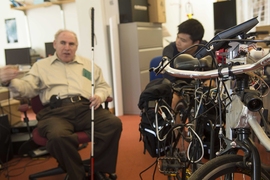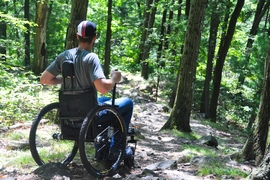What if putting on a raincoat was difficult? What if attending a formal event meant wearing clothing that limited one’s independence? From dress codes to inclement weather, the lack of adaptive clothing can affect the lives of individuals with disabilities in unexpected ways.
After the amputation of her leg, Barbara Harrison expected that “clothes [would] have been the easy part,” she said in a Boston Globe interview. She couldn’t find pants that fit over her prosthetic limb, however, and resorted to wearing shorts even in the worst weather. But “I can’t go to church in shorts,” Harrison added.
Her experience is not unique. Twenty-five years after the Americans with Disabilities Act became law, most clothing is designed without accessibility considerations. The health and fashion industries have yet to create a joint platform to address these issues. Meanwhile, people who cannot access certain apparel or meet specific dress codes cannot participate in the events that call for them, from representing clients in court to going on a date.
A group of recent graduates have come together to change the way we approach clothing design. Grace Teo, who earned her PhD in health sciences and technology from MIT this spring, together with her friend Alice Tin, who has a master’s degree in public health, founded Open Style Lab, a collaborative and interdisciplinary program, to address the lack of adaptive clothing. In its first iteration, which took place during the summer of 2014, the workshop invited eight clients with diverse forms of disability to work with eight student teams, each comprised of an engineer, a designer, and an occupational therapist, to develop clothing for people of all abilities. The students who enrolled in the program came from MIT, Harvard University, Tufts University, Boston University, the Rhode Island School of Design, and the Fashion Institute of Technology, among others. The workshop aimed to solve complex design challenges through a multidisciplinary approach grounded in user-centered design. Expert mentors — designers, engineers, and occupational therapists — provided guidance over the course of workshop. In addition to the students and co-founders, two other team members, Lea Yoon and Kavita Raghavendran, helped support the workshop in various ways.
Assistive technologies are not new to MIT. In fact, one of the early advisors of Open Style Lab was the late MIT professor Seth Teller, who had launched the course 6.811 (Principles and Practices in Assistive Technologies, or PPAT) in the fall of 2011. The lab also collaborated with the Assistive Technology Club, which hosted the 10-week program. Teo is currently co-teaching PPAT with William Li, the president of the MIT Assistive Technology Club.
User-centered design
As part of the user-centered design process, each team aimed to better understand the challenges the client faced in their daily activities. The clients opened their homes to the students and worked together to design and prototype functional yet stylish clothing solutions that addressed their needs.
One of the clients was Ryan DeRoche, a professional racing cyclist who lost mobility in his limbs after a bicycle accident. In their initial meeting, DeRoche demonstrated what it takes to put on a coat: With the help of one of the participating students, Kira Bender, it took a total of five strenuous minutes. DeRoche was often times forced to either not wear a coat, or, in the winter, to keep it on even if he felt too warm after entering an enclosed space such as a warm coffee shop. Both the cold and the sweat are unnecessary threats to his health; those who are afflicted by quadriplegia are at high risk for pneumonia.
After a few iterations, DeRoche’s team — Bender, June Kim, and Alexander Peacock — created the “Rayn Jacket.” Playfully named after DeRoche himself, the jacket is waterproof, slips easily over his arms, and zips in the back with a zipper tether or the help of a friend. The new coat takes only a minute to put on. In fact, the coat is so successful that it will be available for sale within the next spring. For DeRoche, the Rayn Jacket allows him to dress independently and regulate his temperature, but it also enables him to go out even when it rains, to stop by a coffee shop, and take his jacket off if the weather is too warm. In short, it allows him to enjoy simple, everyday activities.
Another prototype that will make it to the market is “Neoclosure,” a magnetic seam that can be covertly incorporated in a variety of clothing articles. Tufts classics professor Steve Hirsch needed a pair of formal pants that suited his needs as a wheelchair user. His team, comprised of Leah Gaffney, Hanna Oh, and Alexandra Billert, developed Neoclosure, which they inserted in the seam of his trousers. In an email correspondence with Teo, Hirsch writes: “And . . . the pants fit very nicely, function smoothly, and are really wonderful to have! Can't wait for a formal occasion to wear them.”
Deniz Aksel, Beth-Ann Latsko, and Niki Patel, the team that worked with Barbara Harrison, created the “Prosthetic Ridge Guard” (PRG), a light but durable brace that is worn over a prosthetic ridge to reduce the friction between the ridge and the pants. They also outfitted her jeans with zippers that allow her to adjust her prosthesis easily. Harrison, who has been wearing shorts or cut-off jeans in the winter, can now wear full-length pants and does not need to suffer through the winter cold.
Transformational projects and reflections
The MIT Public Service Center (PSC) supports students as they work with community members at home or abroad on transformational projects. For Open Style Lab, the PSC offered Teo a PSC Fellowship as well as mentorship and consistent advice. Teo says what she appreciated the most were the weekly reflections — a key component of the fellowship program — and the ongoing support and feedback of Alison Hynd, the PSC director for programs and fellowships administrator. “It’s easy to burn out in these projects to meet the needs of others,” but Hynd always responded with customized advice and encouragement, says Teo.
In the words of Hynd, “One of the things I really enjoyed about Open Style Lab’s development was that the experience was always as important as the final products. Grace and the leadership team worked hard to ensure that the clients, students, and program volunteers were supported and respected at every stage. At their final presentations at Boston’s Museum of Science, the teams’ passion and spirit of co-creation were as impressive as their ingenious designs.”
Learning took place at all levels; students learned from their mentors, their clients, and each other. According to Teo, “our students loved the multidisciplinary teams and the chance to work on a solution that impacted a real-person.”
The future of Open Style Lab
The lab received significant press and participated in major events, including at the Museum of Science and Boston’s Fashion Week. In total, eight products were developed, two of which will be commercialized (the Rayn Jacket and Neoclosure, the latter of which has a pending patent). The Open Style Lab, however, does not stop here. The core team is working on a number of additional initiatives, from planning next year’s program, to a workshop on body image, sexuality, and fashion in partnership with Easter Seals Massachusetts, and an international collaboration with RogLab, a maker lab in Slovenia, among others.
To learn more about the lab and its projects, please visit the Open Style Lab website.









